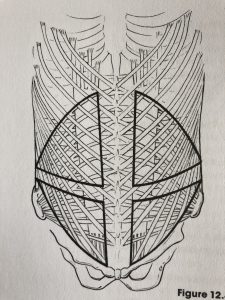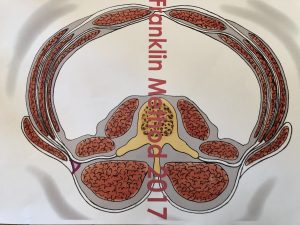Most people who recently birthed a baby experience some level of trying to reignite a relationship with their core muscles. Some people feel a huge disconnect and have little understanding of why their abdomen remains soft even after the rest of their body has started to regain some semblance of it’s former self.
In this episode of Yoga | Birth | Babies, I speak with physical therapist and Franklin Method Educator, Solange Ross and occupational therapist and founder and owner of The Functional Pelvis, Lindsey Vestal. We dive into a deep discussion about diastasis recti, the linea alba and what types of movement can support a healthy core. Plus, at the end I have a quick BONUS conversation with Solange about how postnatal yoga teachers can apply their knowledge of supporting a healthy core function in group classes. This talk is perfect for anyone interested in understanding their abdomen, pelvic floor and back and loves to geek out on anatomy!
In this episode:
- Learn a bit about both Solange and Lindsey
- What is the linea alba and how does it integrated in the abdominal muscles
- How the linea alba affect the abdominal muscles
- How the understanding of diastasis recti is changing
- 3 Myths of diastasis recti
- What people living with diastasic recti should know
- How diastasis recti effects pelvic floor health
- How diastasis recti cause back and pelvic pain
- An explanation of how intrabdominal pressure effects diastasis recti and the linea alba
- How would someone rethicken or repair their linea alba?
- What types of movement can support creating a healthy core
- What should we be aware of when we exercise and move in daily life that could effect the lines alba, DR and pelvic floor issues?
- Evaluating your own linea alba and core
- Final tip or advice for new or expectant parents
- Finding both Solange and Lindsey’s work.
BONUS section– Solange and I have an added conversation about how postnatal yoga teachers can support new parents in a group class and understanding restrictions as one heals.
About Solange:
Solange Ross is a women’s health physical therapist trained in evaluation and treatment of the pelvic floor muscles and Franklin Method Level 2 Educator. Solange works with women prenatally to prepare for birth, postpartum to heal, and during all stages of life to understand how the pelvic floor fits into movement and exercise. Solange uses a full body approach to treatment, looking at breathing, movement, posture, physical demands on the body, and how areas of the body interact with one another. She bridges the importance of daily function and activities into her treatment sessions and empowers women to be an active participant in their healing. www.completecorenyc.com
About Lindsey:
Lindsey Vestal owns The Functional Pelvis, a private practice specializing in pelvic floor therapy “house calls” for pre- and postnatal women. She graduated from NYU with a Master’s of Science in Occupational Therapy. She has dedicated her career to empowering women to find relief from conditions such as bowel and urinary incontinence, constipation, dyspareunia, pelvic pain, prolapse and pre and postnatal complications. She has trained with Herman & Wallace Institute, Maitland, Diane Lee’s Integrated Systems Model, and has received specialized biofeedback training for the pelvic floor. Lindsey teaches pelvic anatomy and pelvic floor health for the Maha Mama pre- and postnatal yoga teacher training in NYC and is an ongoing contributor to Well Rounded NY.
As an OT, she is a passionate promoter of bridging pelvic floor rehabilitation with lifestyle modifications while addressing the psychological impact that pelvic floor issues have on our everyday lives. The pelvic floor is such a vital part of our being and she finds that most people aren’t talking about it enough. She is changing that one pelvic floor at a time. http://www.functionalpelvis.
Additional resources
Here are links to the other podcasts Lindsey did with Yoga | Birth | Babies
What’s Going On With My Core? An Intimate Discussion with Pelvic Floor Therapist Lindsey Vestal
Lindsey referred to the work of Diane Lee and Dr. Sinead Dufour
Images from Solange:
1. The first image shows how the different layers of the abdominals connect into the Linea Albea to create this beautiful latticework. You can see the different angles of how the muscles connect creating strength and support and how if there is not enough movement they can get stuck together. 
2. The second images shows how force gets transferred across the linea alba and how the 2 sides of the abdomen can communicate through the linea alba. The External Oblique connects into the linea alba and then connects to the Internal Oblique on the opposite side of the abdomen. 
Image 1 & 2 from Dynamic Alignment Through Imagery by Eric Franklin.
3. The last image which is from my Franklin Method training is a cross section of the abdominals. You have the Rectus Abdominis at the front, the Erector Spinae at the back between the spinous and transverse processes, and the 3 layers on the side (External Oblique. Internal Oblique, Transverse Abdominis). The connective tissue surrounding all of the abdominals inserts into the linea alba in the front. The connective tissue of the Internal Oblique and Transverse Abdominis connects into the deep muscles that stabilize the spine in the back. This shows the relationship of how the abdominals and DR can affect the lower back because of their fascial connections.







